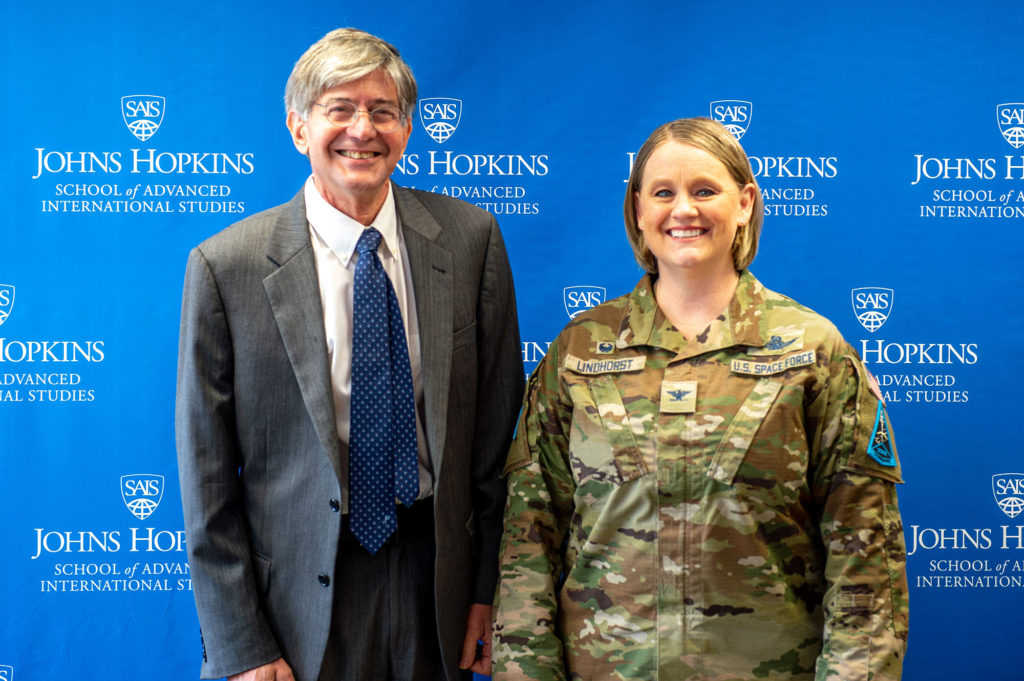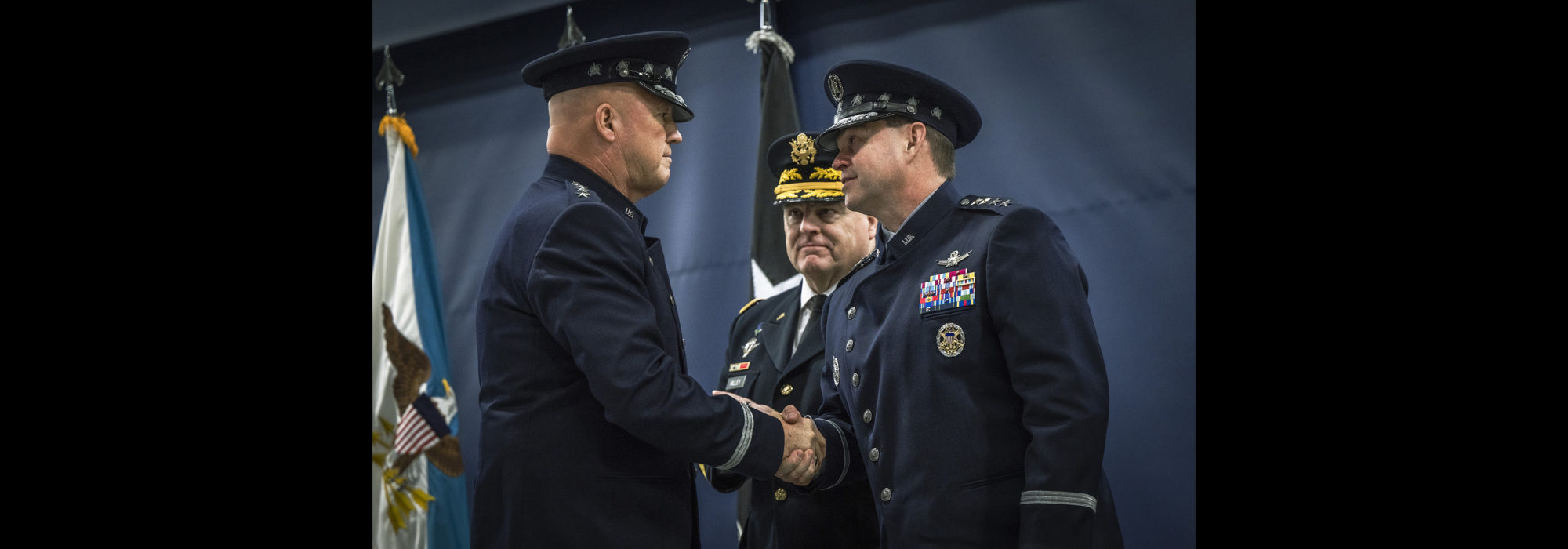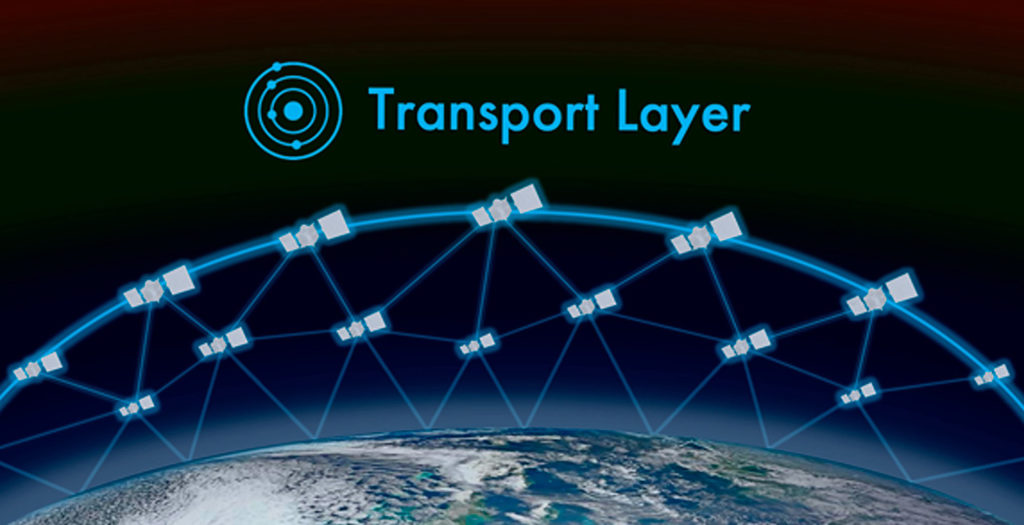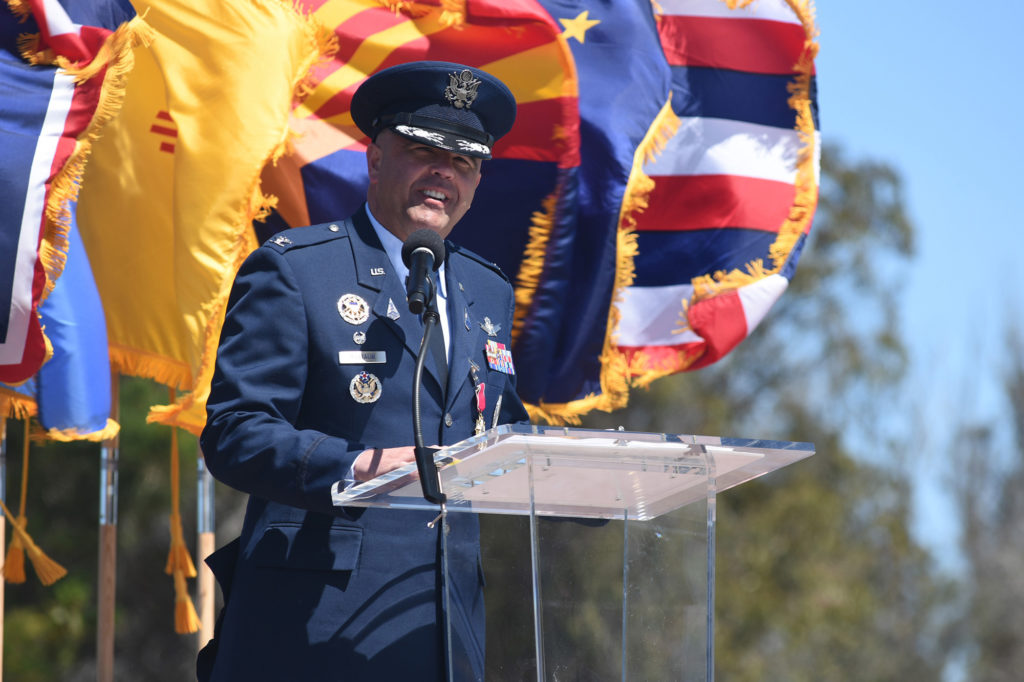Saltzman Succeeds Raymond as Space Force Chief
By Greg Hadley
Gen. B. Chance “Salty” Saltzman succeeded Gen. John W. “Jay” Raymond as Chief of Space Operations in the first-ever leadership change atop the U.S. Space Force.
At just three years old, the Space Force is still in its infancy, its formation having taken place under the watch of Raymond, who retired after 38 years in uniform. He hands the reins to his hand-picked successor, Saltzman, who at 53, will be the youngest, most junior officer to lead a military service in decades.
Saltzman spent the past two years as deputy chief of space operations for operations, cyber, and nuclear. A Weapons School graduate and career operator, he pledged to “work relentlessly to make the Space Force the combat-ready force that our nation needs.”
There’s no one better to take the helm than Gen. B. Chance Saltzman. He knows his way around the space domain.Secretary of Defense, Lloyd Austin III
To the Space Force’s 15,000 Guardians, civilians, and supporting Airmen, he said, “my goal will be to provide you the resources, tools and training, and experiences needed to unlock your massive potential.”
Defense Secretary Lloyd J. Austin III praised Saltzman as perfectly suited to his new role. “There’s no one better to take the helm than Gen. Chance Saltzman,” Austin said. “He knows his way around the space domain. He’s operated satellites. He’s spent many nights at the Joint Space Operations Center during ICBM alerts. And for the past two years, he’s helped this new service get off the ground.”
He will also fill big shoes. Chairman of the Joint Chiefs of Staff Gen. Mark A. Milley said, “Raymond literally wrote the plans, literally wrote the doctrine, and literally developed the capabilities that we see deployed today.”
For his part, Raymond joked that he was now “homeless, unemployed, but humbled and grateful,” and called his time as CSO an “absolute privilege.”
“In establishing the Space Force, the United States capitalized on an opportunity to elevate space to a level that’s consistent with its importance to our national security, and to ensure U.S. and global leadership in the domain,” Raymond said. “And just as the space domain was critical to winning the Cold War, the Space Force represents our nation’s best opportunity to secure peace and deter great power conflict today and into the future.”
SDA Envisions 250 Data-Transport Satellites
By Greg Hadley
The Space Development Agency’s (SDAs) warfighter council will set requirements in March for some 250 satellites in the “Transport Layer” of a planned National Defense Space Architecture.
These low-Earth orbit satellites would be part of a solicitation SDA director Derek M. Tournear anticipates making in spring 2023.
While the agency is still waiting to hear from the council before it finalizes the minimum viable product and exact force design structure for the Tranche 2 Transport Layer, Tournear indicated that the tranche will include “250-ish” satellites for data transport.
That’s about twice the number of satellites included in the Tranche 1 Transport Layer. SDA awarded contracts for that tranche’s 126 satellites in February. The number would also well exceed how many satellites the Space Force currently has in orbit.
SDA’s warfighter council meets twice yearly and guides the agency’s process for determining what capabilities are most important. The council’s next meeting is in March, Tournear said, during a webcast hosted by the National Security Space Association, and the goal is to release a request for proposals for the Tranche 2 Transport Layer “shortly thereafter.”
After that, a contract award will likely follow in the summer of 2023, enabling the program to “hit that September 2026 launch date,” Tournear said. Meanwhile, the architecture’s Tracking Layer won’t be far behind, he said.
“We’re looking at on the order of 50 tracking satellites,” Tournear said. “And the mixture between wide-field-of-view and medium-field-of-view will be determined during the warfighter council … and that will come out later in summer or early fall of 2023, is when the Tranche 2 Tracking solicitation will go.”
Like the Transport Layer, the second tranche of the Tracking Layer, responsible for missile tracking and missile warning, will be roughly double the size of Tranche 1. SDA awarded contracts for 28 satellites for the Tranche 1 Tracking Layer in July.
For both the Transport and Tracking Layers, Tournear said, the second tranches will expand coverage after the initial tranches generate initial warfighting capability.
Tranche 1 “will allow us persistence over given regions of the globe,” Tournear said. “Tranche 2 will give us complete global persistence. So we don’t have to do any kind of prioritization over different areas of the globe. It’ll also give us enough satellites to where we have built-in resilience just because of the numbers of satellites.”
Tranche 1 is scheduled to begin launching in September 2024 and should be finished by mid-2025, Tournear indicated. And that timing could be key as Pentagon officials continue to warn that China is building up its capabilities, with the goal of having the ability to invade Taiwan by 2027.
Tranche 1 will be “ready for the fight in that time frame,” Tournear said. “That will give you the persistence over INDOPACOM for those real-time tactical data links.” Tournear noted. “So that means we will be able to tie in their existing fielded radios … so those tactical radios that our warfighters use on the ground, on ships, and in the air, they’ll be able to talk to the satellites. They’ll be able to communicate targeting data back and forth within each other. Even though they’re outside of what would traditionally be supported by a tactical data link, the space layer will be able to make that global, will be able to tie that back to targeting cells located anywhere in the globe, to be able to move that data in real time in a theater.”
SDA’s next industry solicitation is for an “app factory” for battle management/command, control, and communications (BMC3).
“Basically, it’s the software that will be used by performers on the ground to build the apps and test out the apps in a secure environment to basically do uploads onto the satellite, so that we can upgrade the BMC3 processors on orbit,” Tournear said.
The battle management function of the National Defense Space Architecture is still being fleshed out, and contractors that don’t win the deal for the app factory will still be able to build and offer applications developed for BMC3 in the coming years, Tournear explained. A draft solicitation was released Nov. 9 and the final solicitation is expected in February.

USSF Bypasses AU for Senior Officer Education
By Greg Hadley
The Space Force is partnering with Johns Hopkins University to develop service-specific, in-residence programs at Hopkins’ School of Advanced International Studies in Washington, D.C.—part the service’s new “independent” approach to Professional Military Education (PME).
Unlike the Air Force, which looks to its own Air University for Professional Military Education programs and sends few officers to graduate or fellowships at civilian institutions, the Space Force is forging a new path. Its partnership with Johns Hopkins sets aside 62 seats in 2023 and will grow to include 85 over time. Both military and civilian Space Force staff, as well as international students and officers representing other military services could fill those seats.
Existing Space Force faculty will transfer from Air University to Johns Hopkins, the service noted in a release.
Guardians won’t need to complete distance learning courses to receive credit, Maj. Gen. Shawn N. Bratton, head of Space Training and Readiness Command, told Air & Space Forces Magazine in an exclusive interview. Calling the program “unique” within the military, Bratton said it is based on early direction from the Space Force’s founding Chief of Space Operations, Gen. John W. “Jay” Raymond, who wanted an independent PME program.
“Early on—before there was a STARCOM—Gen. Raymond had written in his planning guidance for the service that we’ll develop independent PME by 2023,” Bratton said. “When I came in to stand up STARCOM, it’s one of the few things that was kind of [a] directive and a specified task, like, ‘You will go do this.’”
Bratton said his staff considered establishing a Space War College to mirror institutions from the other services, but opted not to. “But we’re so small compared to the other services, it just seemed like that would be a lot of bureaucratic growth to develop an independent program,” he noted. “And so early on, we started to talk about partnerships and how we think about that.”
Universities around the Washington, D.C., region, were of primary interest to minimize permanent change of station (PCS) moves. “In about 60 percent of the cases, people will come out of school, and they go to work in the Pentagon,” Bratton said. “That is a pretty common career path when you come out of both intermediate and senior developmental education. So if we can … avoid those moves for kids in school, spouse careers, and [get] a little bit of cost savings for the government in the PCS moves, we thought there was benefit there.”
Avoiding sending Space Force officers to Maxwell Air Force Base, Ala., was also a concern. Many officers and families “voiced concerns about the location at Maxwell Air Force Base in Alabama,” particularly with regard to the quality of local public schools and employment options for spouses, according to a 2021 study by RAND’s Project Air Force.
At Johns Hopkins, Guardians will obtain a master’s in international public policy from one of the top such programs in the world. Foreign Policy magazine recently ranked Johns Hopkins’ master’s in international relations program No. 3 in the entire world, and U.S. News & World Report placed the program in a tie for fourth nationally among Global Policy and Administration Programs.
“As long as you meet the prerequisites, we think there’ll be an opportunity for some Guardians who are pursuing STEM electives, that perhaps they can go up to the Applied Physics Lab and do some work there,” Bratton said. “And so, for sure, we have a huge elective catalog to choose from. It really gives a lot of opportunities for Guardians that wouldn’t be available, certainly, if we had tried to stand up our own school. We just wouldn’t be able to support that with faculty.”
Intermediate developmental education (IDE) and senior developmental education (SDE) mark the top two rungs of the Department of the Air Force’s developmental education program, above primary DE—and include graduate programs, internships, and fellowships. IDE is typically for majors, while SDE is for lieutenant colonels and colonels. The first Guardians to enter the new program will start school in the summer of 2023.
“We’ve made a good choice here in avoiding creating a big bureaucratic institution,” Bratton said. “Hey, we’re a small service. Because of that, we’re able to do things differently than the Army, Navy, and Air Force.”
USAF Setting Up Components for INDOPACOM, CENTCOM, Korea
By Greg Hadley and Amanda Miller
By the end of 2022 the Space Force will have established space components in three critical unified commands. Brig. Gen. Anthony J. Mastalir will fill the first of these at U.S. Indo-Pacific Command, with similar commands to be formed within U.S. Central Command and U.S. European Command “very soon,” a Space Force spokesperson confirmed.
Col. Chris Putman will fill the role at U.S. Central Command, and another officer will be appointed to lead SpaceFor-Korea within at U.S. Forces Korea, a sub-command within INDOPACOM.
These are the first such commands to be established, with the exception of Space Operations Command, which is within U.S. Space Command.
Speaking at the Mitchell Institute for Aerospace Studies’ Spacepower Security Forum, Vice Chief of Space Operations Gen. David D. Thompson said these commands will ensure that the Space Force can collaborate “closely with other combatant commanders to make sure that not only can we understand what they need in terms of space capabilities, but they truly and deeply understand the full suite of capabilities available to them in the United States Space Force, from other military services, to our IC (Intelligence Community) partners, and through the commercial sector.”
‘Space Troopers’
Inside U.S. Space Command, meanwhile, Space Force Brig. Gen. Dennis O. Bythewood assumed command of Joint Task Force-Space Defense on Nov. 4. In that role, he now leads nearly 400 “Space Troopers” at Schriever Space Force Base, Colo., replacing Army Maj. Gen. Thomas L. James, the outgoing commander and simultaneously U.S. Space Command’s director of operations.
James characterized the task force’s “unique and absolutely critical national mission” as “protecting and defending our access to key space systems.” The mission includes space domain awareness, warning satellite operators of threats, and “space superiority,” which is to ensure “the conduct of operations at the time and place of our choosing.”
Some of James’ contributions included the “fusion” of commercial and Missile Defense Agency remote sensing data into the military’s space domain awareness; and the creation of new response options to counter a range of threats. Bythewood now moves up, having been James’ deputy task force commander.
Army Gen. James H. Dickinson, the commander of U.S. Space Command said Bythewood is ready to fill those shoes. “He knows the business and the stakes that are involved today,” said Dickinson. “Dennis displays an intense dedication to the mission and genuine care for his people. Because of his warfighting focus and high integrity, Dennis is ready to assume command of this organization.”
Bythewood said the task force would “continue to innovate as we have the last couple of years to better understand our area of responsibility and execute our space superiority mission.” He said the command is “developing the foundational intelligence needed to maximize our capabilities, and when new ones are delivered, we will synchronize those with support from USSPACECOM.”
Dickinson warned that space is critical to U.S. national security. “We all know when we see the news every day that the Chinese and the Russians are developing and demonstrating capabilities that can hold our space assets at risk,” he said. “Our freedom of access and action in the domain is not guaranteed.”


